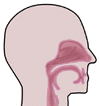  |
||
 |
It is generally considered that as people age they lose both taste and smell function. While there is some truth to this consideration there are several aspects of this concept which require clarification. Both taste and smell function are comprised of two major components: (1) ability to detect tastants and odorants and, (2) ability to recognize these tastants and odorants. DETECTION depends upon the ability of tastants and odorants to bind to sensory receptors. Under normal conditions once this binding occurs the sensory process of taste or smell proceeds in a physiological manner. Detection sensitivity depends upon the presence of normal receptors and the more receptors that are present the faster and more sensitive the process occurs. As people age the number of both taste and smell receptors decrease. Thus, as people age their ability to detect tastants and odorants can and does decrease to some extent. However, there is a broad range over which this occurs. Some people can detect tastants and odorants at levels they did when they were young whereas others do not. Usually, detection may decrease to some extent with age but most people can detect tastants and odorants within what is considered the normal range even at an advanced age. RECOGNITION depends upon the ability to process information obtained from sensory receptors. This processing has several aspects. One aspect is to process receptor information in the brain in the specific region devoted to taste and smell. This process is usually undisturbed by the physiological aging process. Another aspect is to process information from receptors prior to its integration in the brain. This aspect relates to field theory. This aspect states that in order to obtain consistent information about tastants and odorants the number of taste and smell receptors need to be replenished and retained at a constant level throughout the entire life process. This field aspect is the cause of most physiological losses of both taste and smell as people age. It is not that the sensory receptors are malfunctioning. It is just that there are too few receptors to perform the integrative tasks necessary to maintain sensory function as it was maintained during the younger years. In terms of receptor number, the most receptors for both taste and smell are present at birth. It is downhill thereafter. This downhill slide, however, is usually not functionally apparent until people are aged 50 or over and usually not until they were in their 60s or 70s. People can still taste and smell but the intensity of the sensations is less. Thus, if people placed 1 teaspoon of sugar in their coffee to get their expected or required sweetness when they are young, as they age they may use 1½, 2 or even 3 teaspoons of sugar to maintain the same degree of sweetness they experienced when they were young. This same analogy also holds for odors as well only it may be less apparent. Thus, it is the decrease in receptor number that limits people’s ability to taste or smell as they did when they were younger. The receptors themselves are functioning as they did during the earlier years, there are just not enough of them. This functional concept has been well characterized by anatomical studies performed by many investigators at a histological level examining taste bud and olfactory receptor cell anatomy and at a functional level using fMRI of brain. Most patients who complain of loss of taste and smell do so not because of their age but because of some pathological event which injured their sensory system. These injuries include some disease processes, some drug they were taking, some metabolic or nutritional change or some other process which interfered or altered their normal physiological sensory processes. We have published information about changes in taste and smell with aging and you may wish to read more about this. See: Henkin, R.I. Taste loss in aging, in The Biomedical Role of Trace Elements in Aging, (Hsu, J.M., Davis, R.L., Neithamer, Eds.), Eckerd College Gerontology Center, St. Petersburg, FL, 1976, pp.221-236. Home
| The Clinic | Diagnosis
| Treatment | FAQ
| Press
|
|